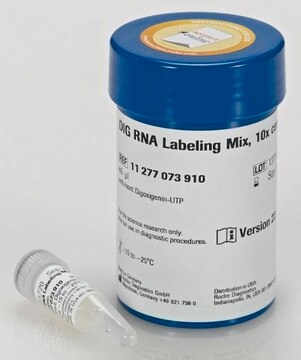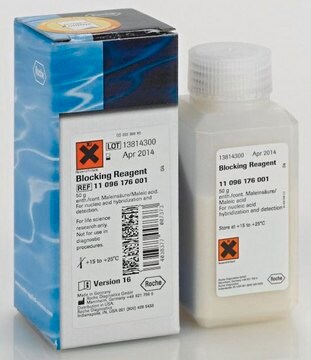RPOLT3-RO
Roche
T3 RNA Polymerase
from Escherichia coli HB101
Sinónimos:
mRNA, polymerase
About This Item
Productos recomendados
origen biológico
Escherichia coli (HB101)
Nivel de calidad
Análisis
100% (SDS-PAGE)
formulario
solution
actividad específica
≥20 U/μL
mol peso
100 kDa (single polypeptide chain)
envase
pkg of 1,000 U (11031163001)
pkg of 5,000 U (11031171001)
fabricante / nombre comercial
Roche
concentración
<0.1 % (w/w)
técnicas
DNA sequencing: suitable
Northern blotting: suitable
Southern blotting: suitable
hybridization: suitable
color
colorless
pH
7.9 (39 °F)
8.0 (68 °F)
solubilidad
water: miscible
idoneidad
suitable for molecular biology
Nº de acceso NCBI
Nº de acceso UniProt
aplicaciones
genomic analysis
life science and biopharma
actividad extraña
Nicking activity 150 units, none detected
RNases 150 units
endonucleases 150 units, none detected
temp. de almacenamiento
−20°C
Información sobre el gen
Escherichia coli ... rpoB(948488)
Categorías relacionadas
Descripción general
Especificidad
T3 RNA polymerase is extremely promoter-specific and only transcribes bacteriophage T3 DNA or DNA cloned downstream of a T3 promoter.
Heat inactivation: Stop the reaction by adding 2 μl 0.2 M EDTA (pH 8.0) and/or heat to 65 °C.
Aplicación
- RNA or DNA blotting techniques
- In situ hybridization
- RNase protection studies: Transcripts synthesized by the enzyme are used as precursor RNA for studies on RNA splicing and processing.
- Synthesis of capped RNA in vitro with addition of m7GpppG or m7GpppA in excess over GTP or ATP during the transcription reaction. The generated antisense RNA can be introduced into cells to suppress the expression of the corresponding genes.
Envase
Calidad
Especificaciones
Synthesis of hybridization probes: T3 RNA polymerase allows highly efficient production of homogeneously labeled RNA. This labeled RNA may be used as hybridization probes in Southern, northern, and dot blots, as well as in situ hybridizations.
Suitable labels: Transcripts can be nonradioactively labeled with biotin-16-UTP, DIG-11-UTP, or fluorescein-12-UTP. They may also be radioactively labeled to high specific activity with [a-32P]- or [a-35S]-labeled nucleotides.
Note: Roche has 10x concentrated RNA Labeling Mixes that are specially designed for DIG-, biotin-, and fluorescein-labeling. These mixes work well with T3 RNA Polymerase.
Definición de unidad
Volume Activity: ≥20 U/μl
Nota de preparación
Almacenamiento y estabilidad
Otras notas
Solo componentes del kit
- T3 RNA Polymerase, in buffer, pH 7.9 ≥20 U/μl
- Transcription Buffer 10x concentrated
Palabra de señalización
Warning
Frases de peligro
Consejos de prudencia
Clasificaciones de peligro
Eye Irrit. 2
Código de clase de almacenamiento
12 - Non Combustible Liquids
Clase de riesgo para el agua (WGK)
WGK 2
Punto de inflamabilidad (°F)
does not flash
Punto de inflamabilidad (°C)
does not flash
Certificados de análisis (COA)
Busque Certificados de análisis (COA) introduciendo el número de lote del producto. Los números de lote se encuentran en la etiqueta del producto después de las palabras «Lot» o «Batch»
¿Ya tiene este producto?
Encuentre la documentación para los productos que ha comprado recientemente en la Biblioteca de documentos.
Los clientes también vieron
Nuestro equipo de científicos tiene experiencia en todas las áreas de investigación: Ciencias de la vida, Ciencia de los materiales, Síntesis química, Cromatografía, Analítica y muchas otras.
Póngase en contacto con el Servicio técnico






